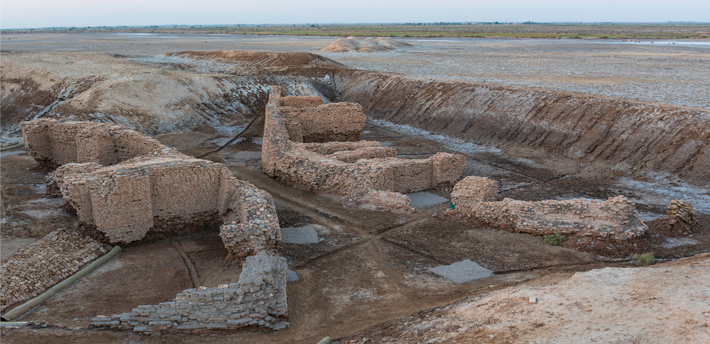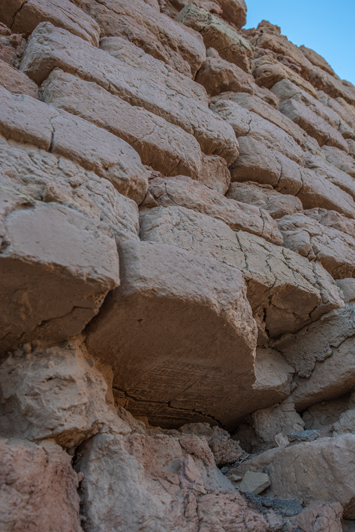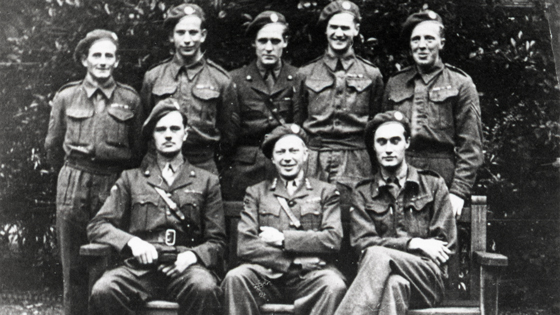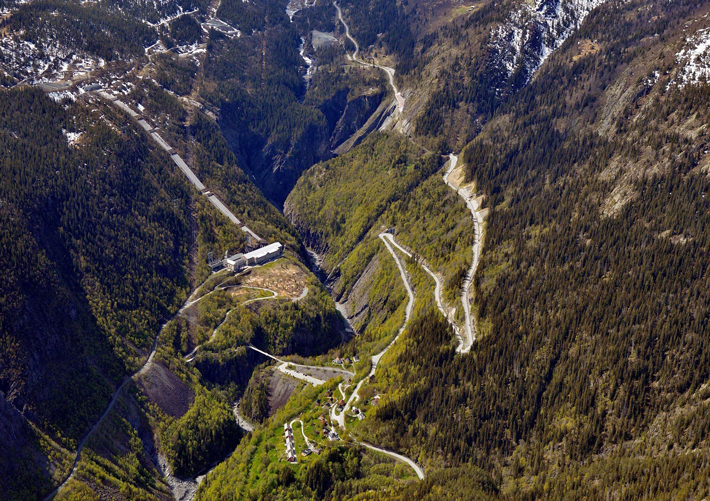Online Exclusives
Girsu’s Enigmatic Construction
By DANIEL WEISS
Tuesday, December 03, 2019

 In the 1920s and early 1930s, French archaeologists at Girsu excavated a monumental brick structure measuring up to 130 feet long by 33 feet wide, with 11-foot-high walls, that resembled a pair of parentheses. Unsure of its purpose, they termed it the “enigmatic construction.” Based on satellite imagery and excavation of the landscape surrounding the structure, British Museum archaeologist Sebastien Rey identified traces of an ancient canal that had once passed directly through the structure. The canal was some 100 feet wide, and Rey concluded that the structure had served as a bottleneck to reduce its width to around 12 feet, narrow enough to be spanned with the planks of a bridge.
In the 1920s and early 1930s, French archaeologists at Girsu excavated a monumental brick structure measuring up to 130 feet long by 33 feet wide, with 11-foot-high walls, that resembled a pair of parentheses. Unsure of its purpose, they termed it the “enigmatic construction.” Based on satellite imagery and excavation of the landscape surrounding the structure, British Museum archaeologist Sebastien Rey identified traces of an ancient canal that had once passed directly through the structure. The canal was some 100 feet wide, and Rey concluded that the structure had served as a bottleneck to reduce its width to around 12 feet, narrow enough to be spanned with the planks of a bridge.
The bridge’s foundation was built of fired bricks coated with bitumen to make it sturdy and watertight. On 15 of these bricks, Rey’s team has identified inscriptions dedicating the structure to the god Ningirsu and naming Ur-Ningirsu (r. ca. 2110 B.C.), the king Gudea’s son and successor as ruler of Girsu. All of these inscriptions faced down lest the god’s name be trod upon.
Standing about a third of a mile to the east of Gudea’s great temple, the bridge would have been the main entrance to Girsu’s sacred precinct, crossed by pilgrims who traveled to the city for religious festivals held several times each year. “That’s why the bridge was so monumental,” says Rey. “It had the same significance as the temple or a city gate or a city wall. It was built by a king and was meant to be visible in the landscape.”
Neolithic Enigmas in 3-D
Tuesday, August 07, 2018
National Museums Scotland used a technique called photogrammetry, which combines hundreds of still images, to produce this interactive 3-D model of several examples of 5,000-year-old stone spheres that have been found mostly in Scotland. To read more about researchers' study of the spheres, click here.
Recreating a Renaissance Song
Wednesday, June 07, 2017
After archaeologists in France unearthed a schist plaque inscribed with a sixteenth-century musical score, they turned to soprano Dominique Fontaine to decode the notes. Fontaine, a member of the musical ensemble Ad Lib, which specializes in sacred music, recorded her interpretation of the brief chant.
To read more about the discovery, go to “Renaissance Melody.”
3-D Walkthrough of Vemork Plant
Monday, December 11, 2017
This 3-D walkthrough of the heavy water facilities at Norway’s Vemork Plant was created by Telemark County Council archaeologist Sindre Arnkværn. The plant was demolished in 1977 and little documentation or study of the site had been conducted since Operation Gunnerside in 1943. Although researchers had to make their way through demolition rubble, they still were able to understand Gunnerside’s events in the location and context in which they occurred. To read a full article on the archaeology of the site, go to “The Secrets of Sabotage.” (Courtesy Sindre Arnkværn/Telemark County Council)
|
Slideshow:
|
Article:
|

Operation Gunnerside
|

The Secrets of Sabotage
|
The Dawn of Digital Music
By SAMIR S. PATEL
Friday, February 10, 2017
In 1951, the BBC recorded three melodies—“God Save the King,” “Baa Baa Black Sheep,” and Glenn Miller’s “In the Mood"—generated by mathematician Alan Turing's pioneering Mark II computer. It is the earliest known recording of computer music. Researchers recently analyzed and processed the recording, which includes the voices of people in the room, to restore the original sound of this founding artifact of the age of digital music.
To read in-depth about the recording, go to "Digging up Digital Music."
Advertisement
Advertisement
Advertisement

Recent Issues
-
 May/June 2024
May/June 2024
-
 March/April 2024
March/April 2024
-
 January/February 2024
January/February 2024
-
 November/December 2023
November/December 2023
-
 September/October 2023
September/October 2023
-
 July/August 2023
July/August 2023
-
 May/June 2023
May/June 2023
-
 March/April 2023
March/April 2023
-
 January/February 2023
January/February 2023
-
 November/December 2022
November/December 2022
-
 September/October 2022
September/October 2022
-
 July/August 2022
July/August 2022
-
 May/June 2022
May/June 2022
-
 March/April 2022
March/April 2022
-
 January/February 2022
January/February 2022
-
 November/December 2021
November/December 2021
-
 September/October 2021
September/October 2021
-
 July/August 2021
July/August 2021
-
 May/June 2021
May/June 2021
-
 March/April 2021
March/April 2021
-
 January/February 2021
January/February 2021
-
 November/December 2020
November/December 2020
-
 September/October 2020
September/October 2020
-
 July/August 2020
July/August 2020
-
 May/June 2020
May/June 2020
-
 March/April 2020
March/April 2020
-
 January/February 2020
January/February 2020
-
 November/December 2019
November/December 2019
-
 September/October 2019
September/October 2019
-
 July/August 2019
July/August 2019
-
 May/June 2019
May/June 2019
-
 March/April 2019
March/April 2019
-
 January/February 2019
January/February 2019
-
 November/December 2018
November/December 2018
-
 September/October 2018
September/October 2018
-
 July/August 2018
July/August 2018
-
 May/June 2018
May/June 2018
-
 March/April 2018
March/April 2018
-
 January/February 2018
January/February 2018
-
 November/December 2017
November/December 2017
-
 September/October 2017
September/October 2017
-
 July/August 2017
July/August 2017
-
 May/June 2017
May/June 2017
-
 March/April 2017
March/April 2017
-
 January/February 2017
January/February 2017
-
 November/December 2016
November/December 2016
-
 September/October 2016
September/October 2016
-
 July/August 2016
July/August 2016
-
 May/June 2016
May/June 2016
-
 March/April 2016
March/April 2016
-
 January/February 2016
January/February 2016
-
 November/December 2015
November/December 2015
-
 September/October 2015
September/October 2015
-
 July/August 2015
July/August 2015
-
 May/June 2015
May/June 2015
-
 March/April 2015
March/April 2015
-
 January/February 2015
January/February 2015
-
 November/December 2014
November/December 2014
-
 September/October 2014
September/October 2014
-
 July/August 2014
July/August 2014
-
 May/June 2014
May/June 2014
-
 March/April 2014
March/April 2014
-
 January/February 2014
January/February 2014
-
 November/December 2013
November/December 2013
-
 September/October 2013
September/October 2013
-
 July/August 2013
July/August 2013
-
 May/June 2013
May/June 2013
-
 March/April 2013
March/April 2013
-
 January/February 2013
January/February 2013
-
 November/December 2012
November/December 2012
-
 September/October 2012
September/October 2012
-
 July/August 2012
July/August 2012
-
 May/June 2012
May/June 2012
-
 March/April 2012
March/April 2012
-
 January/February 2012
January/February 2012
-
 November/December 2011
November/December 2011
-
 September/October 2011
September/October 2011
-
 July/August 2011
July/August 2011
-
 May/June 2011
May/June 2011
-
 March/April 2011
March/April 2011
-
 January/February 2011
January/February 2011
Advertisement






